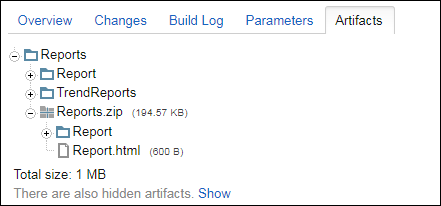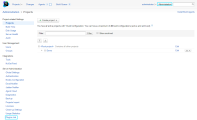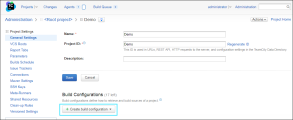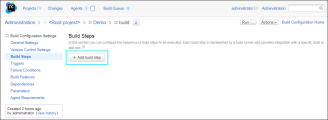LoadRunner Enterprise and TeamCity
The TeamCity plugin enables you to run tests as part of your CI/CD process.
Install and deploy the TeamCity plugin
This task describes how to install and deploy the LoadRunner Enterprise CI plugin for TeamCity.
-
Verify that your TeamCity server is up and running. Refer to the product documentation for more details.
For the supported server versions, see the Integrations section of the System Requirements guide.
-
Download the LoadRunner Enterprise CI plugin extension file which is available from: https://plugins.jetbrains.com/plugin/10694-performance-center-ci
-
Install the plugin.
-
From TeamCity > Administration, under Server Administration click Plugins List.
-
In the Plugins List page, click Available plugins and search for "LoadRunner Enterprise".
- The External plugins page opens and displays the LoadRunner Enterprise CI plugin. Click
 Download plugin.
Download plugin. - After downloading the plugin, in the Plugins List page click Upload plugin zip to upload the LoadRunner Enterprise CI plugin.
- Restart your TeamCity server.
-
Add a LoadRunner Enterprise test to your build step in TeamCity
This task describes how to test to your build step in TeamCity.
-
In your TeamCity project, create a new build and enter the required configuration details.
-
For the build you created, select Build Steps and click Add build step.
-
Select the LoadRunner Enterprise Test build runner type.
-
Add the following step details:
Argument Description Runner type Displays PC Test, the build runner type you selected in the previous step. Step name (Optional) Enter a name to distinguish this build step from other steps. Parameters PC Server Enter the hostname or IP address of a LoadRunner Enterprise server.
Example: If the LoadRunner Enterprise server URL is
http://MY_SERVER/loadtest, enterMY_SERVER.Use HTTPS Protocol Select if you are running the TeamCity build over a secured LoadRunner Enterprise server. Use token for authentication Select if you are using SSO or LDAP security tokens to authenticate to the LoadRunner Enterprise server.
<LRE credentials>
Depending on the authentication type required by your LoadRunner Enterprise server, credentials can be a username and password, or an API key for SSO or LDAP authentication.
-
Username and password:
User name. Enter the user name required to connect to the LoadRunner Enterprise server.
Password. Enter the password required to connect to the LoadRunner Enterprise server.
-
SSO or LDAP authentication:
When Use token for authentication is selected, enter the Client ID and Secret key obtained from your LoadRunner Enterprise site administrator in the Id Key and Secret key fields. For details, see Set up API access.
Domain Enter the LoadRunner Enterprise domain. PC Project Enter the name of the LoadRunner Enterprise project. Test ID Enter the Test ID. You can get the ID from LoadRunner Enterprise > Test Management > Test Plan view. Select your test and find the ID in the General Details: ID <number>. Test Instance ID Select an option for adding the Test Instance ID:
-
Automatically select existing or create new if none exists. If you select this option, LoadRunner Enterprise creates a test instance or locates the existing test instance.
-
Manual selection. Enter the Test Instance ID from the Assign and Select Test Set dialog box. For details, see To edit a test set:.
Local Proxy Choose whether to use a local proxy (leave empty if not using a local proxy).
If you use a proxy, enter a proxy in the format
http(s)://host:port, and enter the user name and password.Note: PAC (proxy auto-config) or Automatic configuration script are not supported.
Post Run Action Choose a Post Run Action: Collate Results, Collate and Analyze, or Do Not Collate. Trending Select a trend report option:
-
Do Not Trend. No trend report is created.
-
Use trend report associated with the test. If Auto Trending is selected in the Load Test, select this option to automatically publish trend results.
-
Add run to trend report with ID. If you select this option, enter the trend report ID.
Timeslot Duration Enter a duration for the Ad-Hoc timeslot.
Maximum: 480 hours
Minimum: 30 minutes
Use VUFDs
Choose whether to use a Virtual User Flex Days (VUFD) license. This provides you with a specified number of Vusers (VUFDs) that you can run an unlimited number of times within a 24 hour period.
Before using this option, make sure that VUFD licenses are applied in your LoadRunner Enterprise environment.
Set step status according to SLA Select this option to set the build-step status according to a predefined SLA (Service Level Agreement) configured within your performance test.
If you do not select this option, the build-step is labeled as "Passed" as long as no failures occurred.
On Timeslot creation failure Choose an action to perform if the timeslot cannot be created: Do not repeat (the task ends), or Repeat with the following parameters:
-
Delay between attempts. Amount of time, in minutes, to wait between a failed attempt and the next attempt (the minimum is 1 and the maximum is 10).
-
Number of attempts. The number of attempts to run the test (the minimum is 2 and the maximum is 10).
-
-
Save your build step settings.
View test results
After a test run, LoadRunner Enterprise automatically saves the run results as an artifact with the build.
Navigate to the build artifacts specified in the Artifact path and locate the Report.html file to view the test results. You can also review the Trend reports if selected.

 See also:
See also:
















